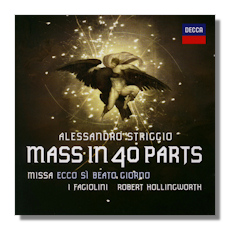
The Internet's Premier Classical Music Source
Related Links
-
Galilei Reviews
Striggio Reviews
Tallis Reviews - Latest Reviews
- More Reviews
-
By Composer
-
Collections
DVD & Blu-ray
Books
Concert Reviews
Articles/Interviews
Software
Audio
Search Amazon
Recommended Links
Site News
 CD Review
CD Review
Alessandro Striggio

Mass in 40 Parts
- Alessandro Striggio:
- Mass "Missa Ecco sì beato giorno"
- Motet "Ecce beatam lucem"
- Madrigal "Fuggi, Spene Mia"
- Madrigal "O Giovenil Ardire"
- Madrigal "Altr'io Queste Spighe"
- Madrigal "D'ogni Gratia Et D'amor"
- Madrigal "O De La Bella Etruria"
- Madrigal "Caro Dolce Ben Mio"
- Madrigal "Misero Ohime"
- Vincenzo Galilei: Contrapunto Secondo di B.M.
- Anonymous (plainchant): Spem in alium
- Thomas Tallis: Motet "Spem in alium"
I Fagiolini/Robert Hollingworth
Decca 4782734 CD+DVD 68m+57m
For those who admire renaissance polyphony at its best, this issue is not only a revelation but an event of immense importance, as it focuses on Striggio's 40 part-mass which was lost for over 400 years.
Born circa 1536/37 Alessandro Striggio was the son of a Mantuan nobleman and soldier. In 1559 he was employed in the service of Duke Cosimo I de Medici in Florence, where he soon became the highest-paid member of the musical establishment. This elevated social status allowed him a dual musical-diplomatic post, and he divided his activities between work for the Medici family and the court in Mantua. He wrote a huge amount of madrigals and many other pieces - both sacred and profane - that were later published in several anthologies, and by the time of his death in 1596, his music was widely performed. Since then, history has not been so kind, and his compositions became something of a rarity, so this smashing Decca issue is both welcome and timely.
The 1566 Mass "Ecco si beato giorno' has strong similarities to the 1561 motet "Ecce beatam lucem', and some believe that Striggio built the Mass on the motet's ideas. Whatever the case, both are on a gargantuan scale and laid out for the same combination of parts. A striking feature of both works (Tracks 1 – 8) is that the same 13 parts (plus 4 more in the Mass) employ florid and syncopated writing which results in creating an effect of a melodic ivy entwined around gigantic harmonic pillars. The Mass was performed on three occasions during Striggio's lifetime, but then disappeared, until David Moroney unearthed the parts in Paris very recently. The set also includes choral pieces by Galilei and Tallis, and a magnificent DVD featuring "The Making of Striggio' and audio performances of the "Ecce' and "Ecco' pieces and "Spem in alium' in the Tallis and plainchant versions. A mystical experience, full of glowing sounds and intricately weaved patterns of shimmering beauties that nourish the soul from start to finish. Performances, sound and presentation are immaculate. My choral disc of the year.
Copyright © 2011, Gerald Fenech





















